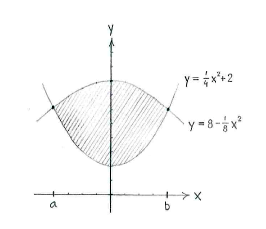Lösung 2.1:4c
Aus Online Mathematik Brückenkurs 2
K (Solution 2.1:4c moved to Lösung 2.1:4c: Robot: moved page) |
|||
| Zeile 1: | Zeile 1: | ||
| - | + | Zuerst sehen wir in der Figur welches unseres Gebiet ist. | |
| - | + | Die Kurven <math>y=x^2/4+2</math> und <math>y=8-x^2/8</math> sind beide quadratische Funktionen. Die erste hat das Minimum <math>y=2</math> wenn <math>x=0</math>, und die zweite das Maximum <math>y=8</math> wenn <math>x=0</math>. Die Kurven sehen ungefähr wie im Bild unten aus. | |
[[Image:2_1_4_c.gif|center]] | [[Image:2_1_4_c.gif|center]] | ||
| - | + | Die obere Grenze der Fläche ist die Funktion <math>y=8-x^2/8</math> und die untere Grenze die Funktion <math>y=x^2/4+2</math>. Bestimmen wir die Schnittstellen <math>x=a</math> und <math>x=b</math> der beiden Kurven, ist die Fläche | |
{{Abgesetzte Formel||<math>\text{Area} = \int\limits_{a}^{b} \bigl(\bigl(8-\tfrac{1}{8}x^2\bigr) - \bigl(\tfrac{1}{4}x^2+2\bigr)\bigr)\,dx\,\textrm{.}</math>}} | {{Abgesetzte Formel||<math>\text{Area} = \int\limits_{a}^{b} \bigl(\bigl(8-\tfrac{1}{8}x^2\bigr) - \bigl(\tfrac{1}{4}x^2+2\bigr)\bigr)\,dx\,\textrm{.}</math>}} | ||
| - | + | Die Fläche ist der Integral des Unterschiedes zwischen den beiden Funktionen. | |
| - | + | Wir erhalten die Schnittstellen durch folgende Gleichung; | |
{{Abgesetzte Formel||<math>\left\{\begin{align} | {{Abgesetzte Formel||<math>\left\{\begin{align} | ||
| Zeile 18: | Zeile 18: | ||
\end{align}\right.</math>}} | \end{align}\right.</math>}} | ||
| - | + | Eliminieren Wir ''y'', und lösen die Gleichung für ''x'', erhalten wir die Schnittstellen | |
{{Abgesetzte Formel||<math>8-\tfrac{1}{8}x^2 = \tfrac{1}{4}x^2+2\,\textrm{.}</math>}} | {{Abgesetzte Formel||<math>8-\tfrac{1}{8}x^2 = \tfrac{1}{4}x^2+2\,\textrm{.}</math>}} | ||
| - | + | oder | |
{{Abgesetzte Formel||<math>\tfrac{1}{4}x^2 + \tfrac{1}{8}x^2 = 8-2\,,</math>}} | {{Abgesetzte Formel||<math>\tfrac{1}{4}x^2 + \tfrac{1}{8}x^2 = 8-2\,,</math>}} | ||
| - | + | also ist | |
{{Abgesetzte Formel||<math>\begin{align} | {{Abgesetzte Formel||<math>\begin{align} | ||
| Zeile 34: | Zeile 34: | ||
\end{align}</math>}} | \end{align}</math>}} | ||
| - | + | Also sind die Schnittstellen <math>x=-4</math> und <math>x=4\,</math>. | |
| - | + | Die Flche zwischen den Kurven ist also | |
{{Abgesetzte Formel||<math>\begin{align} | {{Abgesetzte Formel||<math>\begin{align} | ||
Version vom 18:49, 28. Apr. 2009
Zuerst sehen wir in der Figur welches unseres Gebiet ist.
Die Kurven \displaystyle y=x^2/4+2 und \displaystyle y=8-x^2/8 sind beide quadratische Funktionen. Die erste hat das Minimum \displaystyle y=2 wenn \displaystyle x=0, und die zweite das Maximum \displaystyle y=8 wenn \displaystyle x=0. Die Kurven sehen ungefähr wie im Bild unten aus.
Die obere Grenze der Fläche ist die Funktion \displaystyle y=8-x^2/8 und die untere Grenze die Funktion \displaystyle y=x^2/4+2. Bestimmen wir die Schnittstellen \displaystyle x=a und \displaystyle x=b der beiden Kurven, ist die Fläche
| \displaystyle \text{Area} = \int\limits_{a}^{b} \bigl(\bigl(8-\tfrac{1}{8}x^2\bigr) - \bigl(\tfrac{1}{4}x^2+2\bigr)\bigr)\,dx\,\textrm{.} |
Die Fläche ist der Integral des Unterschiedes zwischen den beiden Funktionen.
Wir erhalten die Schnittstellen durch folgende Gleichung;
| \displaystyle \left\{\begin{align}
y &= 8-\tfrac{1}{8}x^2\,,\\[5pt] y &= \tfrac{1}{4}x^2+2\,\textrm{.} \end{align}\right. |
Eliminieren Wir y, und lösen die Gleichung für x, erhalten wir die Schnittstellen
| \displaystyle 8-\tfrac{1}{8}x^2 = \tfrac{1}{4}x^2+2\,\textrm{.} |
oder
| \displaystyle \tfrac{1}{4}x^2 + \tfrac{1}{8}x^2 = 8-2\,, |
also ist
| \displaystyle \begin{align}
\bigl(\tfrac{1}{4}+\tfrac{1}{8}\bigr)x^2 &= 6\,,\\[5pt] \tfrac{3}{8}x^2 &= 6\,,\\[5pt] x^2 &= 16\,\textrm{.} \end{align} |
Also sind die Schnittstellen \displaystyle x=-4 und \displaystyle x=4\,.
Die Flche zwischen den Kurven ist also
| \displaystyle \begin{align}
\text{Area} &= \int\limits_{-4}^{4} \Bigl(\Bigl(8-\frac{1}{8}x^2\Bigr)-\Bigl( \frac{1}{4}x^2+2\Bigr) \Bigr)\,dx\\[5pt] &= \int\limits_{-4}^{4}\Bigl(8-\frac{1}{8}x^2-\frac{1}{4}x^2-2\Bigr)\,dx\\[5pt] &= \int\limits_{-4}^{4}\Bigl(6-\Bigl(\frac{1}{8}+\frac{1}{4}\Bigr)x^2\Bigr)\,dx\\[5pt] &= \int\limits_{-4}^{4}\Bigl(6-\frac{3}{8}x^2\Bigr)\,dx\\[5pt] &= \Bigl[\ 6x-\frac{3}{8}\frac{x^3}{3}\ \Bigr]_{-4}^{4}\\[5pt] &= \Bigl[\ 6x-\frac{x^3}{8}\ \Bigr]_{-4}^{4}\\[5pt] &= 6\cdot 4 - \frac{4^3}{8} - \Bigl(6\cdot (-4) - \frac{(-4)^3}{8}\Bigr)\\[5pt] &= 24-8+24-8\\[5pt] &= 32\,\textrm{.} \end{align} |

